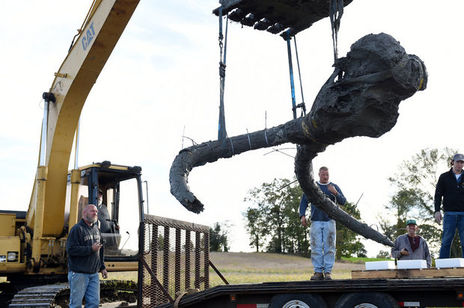 The skull of a mammoth is hoisted from a muddy field near Chelsea, Michigan.
The skull of a mammoth is hoisted from a muddy field near Chelsea, Michigan. There's no doubt the unearthing of the mammoth captured the public's attention -- the extent of the press coverage demonstrates that pretty clearly. The images of the enormous, tusked skull being hoisted out of the ground are hard to beat for drama. But I know from conversations and comments that I saw online that many archaeologists have questions about the excavation that go beyond the "gee whiz" factor that the press and the nonprofessional public love. I'm probably going to get some flack for writing this post, but I'm going to write it anyway and give voice to some of those questions.
Full disclosure: I met Dr. Dan Fisher when I was a graduate student at the University of Michigan, and I know several of the archaeologists who were involved with excavating the mammoth.
Fisher has spent decades building a case that Ice Age humans in the Great Lakes were hunting mastodons and mammoths, butchering their remains, and storing pieces of the animals underwater to retrieve later. His argument is based on a pattern of partial skeletons (some with cutmarks) found in wet settings with artifacts suggesting the carcass locations were marked. He has done experiments to show that meat can be kept edible for long periods of time by submerging it in cold water. Formal stone tools (such as scrapers and projectile points) are not found at these "sub-aqueous caching" sites, and given the nature of what's being proposed there really isn't any reason to expect that they would be. I haven't read all of his papers carefully, but my general impression is that the case is a good one. And it's interesting. Here is a (somewhat dated) summary article from Mammoth Trumpet that lays out the main points.
Fisher thinks that the Chelsea mammoth unearthed in Michigan last week, like many other sets of remains he has considered, was probably butchered and stored underwater. The following paragraphs are from the University of Michigan press release:
"The team's working hypothesis is that ancient humans placed the mammoth remains in a pond for storage. Caching mammoth meat in ponds for later use is a strategy that Fisher said he has encountered at other sites in the region.
Evidence supporting that idea includes three basketball-sized boulders recovered next to the mammoth remains. The boulders may have been used to anchor the carcass in a pond.
The researchers also recovered a small stone flake that may have been used as a cutting tool next to one of the tusks. And the neck vertebrae were not scattered randomly, as is normally the case following a natural death, but were arrayed in their correct anatomical sequence, as if someone had "chopped a big chunk out of the body and placed it in the pond for storage," Fisher said."
So the key pieces of evidence are: big rocks next to the remains; stone flake; articulated neck vertebrae. Check, check, and check. In my opinion, that all seems to make sense. Even better if the tell-tale cutmarks are present where Fisher expects to find them.
It's not the working hypothesis I'm worried about, however, but whether the information produced by the excavation in Chelsea is going to be sufficient to really evaluate that hypothesis. I think what bothered many archaeologists about the Chelsea mammoth excavation is what we saw (or didn't see) in the stills and videos from the single day of excavation.
Yes, they excavated an entire mammoth from 8-10' underground in a single day.
A day.
I once spent at least two days excavating the burial of small dog.
The news articles explain that the Chelsea mammoth was excavated in a single day because that's all the time that was available (the following is from the Washington Post):
"After establishing that [the landowner and farmer] Bristle could only spare one day for the mammoth extraction, Fisher and his team went into overdrive. On Thursday they were deep in the muck, doing their best to carefully document and extract the bones at top speed.
“We don’t just want to pull the bones and tug everything out of the dirt,” Fisher explained. “ We want to get the context for how everything was placed at the site.”
There are a few things that make this particular mammoth exciting: It’s a very complete skeleton (although it is missing its hind limbs, feet and some other assorted parts), compared with most of the mammoths found in Michigan and surrounding areas. And because it has been carefully extracted by paleontologists, the bone has the potential to be studied much more thoroughly than those that are haphazardly pulled out of the ground.
"We'll have the potential to say way more about this specimen,” because of the careful excavation, Fisher said."

Non-archaeologists may be impressed (or dismayed) by how much time we can spend picking away at things in the field, drawing maps, filling out logs, arguing over sediments, writing notes, taking photographs, etc. But the fact is that we're not just wasting time: details matter when you're trying to understand what you're taking apart. The working hypothesis is that the Chelsea mammoth site was the product of human behavior, so, yes, context and associations matter a great deal when you're trying to understand how the site was created. Archaeological work, ideally, is careful and thorough enough to let you more-or-less put the site back together in a virtual fashion based on the information you collect as you take it apart. Excavation is destruction, and you don't get a do-over.
It's hard for me to put aside my feelings about the importance of control and details and get super excited about raising the skull out of the ground when I look at the images from the Chelsea mammoth excavation. In the video clips I saw, it looked like an incredibly sloppy, irregular operation. I know that I saw only what TV cameras and news photographers chose to show me, but I saw no evidence of how spatial control was being maintained (no grid? no total station for electronic mapping?), and no hint of the existence of a level of care that I would normally associate with professional archaeology. Was there a screen? How about a profile wall? I really don't know. I've seen WWF mud wrestling matches that looked more controlled than what I saw in some of the images from that excavation.
If you think I'm being too picky, I invite you to compare and contrast what you see in the images from the Chelsea mammoth excavation with this mammoth excavation in Kansas, or this one in Mexico,or the multiple seasons of work that took place on the Schaefer mammoth site in Wisconsin, or this short 2008 paper about the excavation of mastodons from wet sites in New York. Those examples are far more typical of what a professional excavation of a human-associated mammoth site generally looks like. These things are generally not unearthed during the course of single day for a reason: you lose information. A story about a mastodon being excavated by amateurs and volunteers in Virginia describes what might be considered a "normal" procedure:
"Scans produced by ground-penetrating radar have shown that bone-size objects are waiting about five feet down. Four feet of soil will be dug out using heavy equipment, then the last foot will be carefully removed by hand."
Why the rush to remove the Chelsea mammoth in just a single day? I don't really know the answer to that. The news stories report that the farmer "could only spare one day for the mammoth extraction," but they don't say what would have happened if the mammoth had not been removed during that single day. Was this some kind of "now or never" situation that justified quickly yanking the bones out of the field? Was the mammoth going to be destroyed if it was left in place? Was it going to turn into a pumpkin if it wasn't out of the ground by Thursday at midnight?
Maybe leaving the mammoth in the ground until it could be carefully excavated in the spring (or a year or two down the road) really wasn't an option. Maybe whatever plan there was for drainage was actually going to totally destroy the site and there was no way to simply avoid the mammoth until arrangements could be made to do what has been done in the past for similar finds: use probes or geophysics to delimit the bone scatter, use heavy equipment to strip off the overburden, and then treat the remains as an archaeological site using standard excavation methods. Maybe the single day, salvage-style excavation really was the best option. I honestly don't know.
What I do know, however, is that I'll be surprised if the manner in which the Chelsea mammoth was excavated has no adverse impacts on how the analysis and interpretation of the remains are regarded by archaeologists in the Midwest and elsewhere. The nature of Clovis and pre-Clovis occupations in the Great Lakes is still controversial, and I'm concerned that the potential of the Chelsea mammoth to contribute important information to the debate has been lessened by the speed and style of the excavation. It's hard to look at those pictures of the excavation, know that it was all done in one day, and not wonder what would have been different if more time and care had been taken.
I know from social media that I'm not the only one asking the "why" and "what if" questions about the Chelsea mammoth excavation, but I am the one writing them down and I'll be the one to take the heat for them. I probably won't make any new friends with this post. I may even get told that I'm out of line. That's fine. Calling me names won't make the questions go away, and I've been called names plenty of times. I think the discovery is exciting, and I hope my "outsider" impressions of the excavation are incorrect. I look forward to reading the published results.


 RSS Feed
RSS Feed
